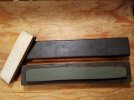- Joined
- Apr 12, 2009
- Messages
- 13,507
Which could easily be done with a pasted strop or even clean leather.
Absolutely true.

My only point being, they can be used as such if it's handy to do so, but would still be limited in terms of their ability to significantly alter or shape an edge on a more wear-resistant steel. That can be used to advantage, in some situations.
Some stiff burrs on fairly hard, but still ductile steels like VG-10, ATS-34 (strongest burrs I've ever seen, at ~ HRC 60 or so) won't be easily removed on bare leather alone, which won't be dense enough or hard enough to bend or 'flip' the burr in pursuit of breaking it off. And a pasted strop is more likely to do some polishing or other finish alteration as well, assuming the paste's abrasive is intended to abrade the burrs away, as opposed to just breaking them off. For example, I've always liked a denim strop with white rouge for very aggressive, fast deburring of VG-10. But in doing so, it also polishes the steel very fast. Sometimes polishing is a goal too, in using that strop; but sometimes it's not, and something else to get the burrs cleaned up is preferable.
Last edited:







